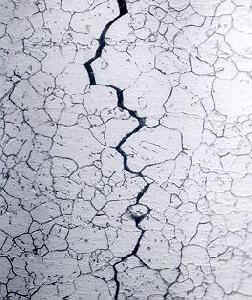Stress Corrosion Cracking (SCC)

Stress corrosion cracking (SCC) is the cracking induced from the combined influence of tensile stress and a corrosive environment. The impact of SCC on a material usually falls between dry cracking and the fatigue threshold of that material. The required tensile stresses may be in the form of directly applied stresses or in the form of residual stresses, see an example of SCC of an aircraft component. The problem itself can be quite complex. The situation with buried pipelines is a good example of such complexity. The impact is most commonly catastrophic but rarely as it was for the historical failure of the UK Flixborough chemical reactor in 1974.
Cold deformation and forming, welding, heat treatment, machining and
grinding can introduce residual stresses. The magnitude and importance of
such stresses is often underestimated. The residual stresses set up as a
result of welding operations tend to approach the yield strength. The build-up
of corrosion products in confined spaces can also generate significant stresses
and should not be overlooked. SCC usually occurs in certain specific alloy-environment-stress
combinations.
Usually, most of the surface remains unattacked, but with fine cracks penetrating into the material. In the microstructure, these cracks can have an intergranular or a transgranular morphology. Macroscopically, SCC fractures have a brittle appearance. SCC is classified as a catastrophic form of corrosion, as the detection of such fine cracks can be very difficult and the damage not easily predicted. Experimental SCC data is notorious for a wide range of scatter. A disastrous failure may occur unexpectedly, with minimal overall material loss.
The micrograph on the right (X500) illustrates intergranular SCC of an Inconel heat exchanger tube with the crack following the grain boundaries. (photo courtesy of Metallurgical Technologies)
 The
micrograph on the left (X300) illustrates SCC in a 316 stainless steel chemical
processing piping system.Chloride stress corrosion cracking in austenitic
stainless steel is characterized by the multi-branched "lightning bolt"
transgranular crack pattern. (photo
courtesy of Metallurgical Technologies)
The
micrograph on the left (X300) illustrates SCC in a 316 stainless steel chemical
processing piping system.Chloride stress corrosion cracking in austenitic
stainless steel is characterized by the multi-branched "lightning bolt"
transgranular crack pattern. (photo
courtesy of Metallurgical Technologies)
The most effective means of preventing SCC are: 1) properly with the right materials; 2) reduce stresses; 3) remove critical environmental species such as hydroxides, chlorides, and oxygen; 4) and avoid stagnant areas and crevices in heat exchangers where chloride and hydroxide might become concentrated. Low alloy steels are less susceptible than high alloy steels, but they are subject to SCC in water containing chloride ions.
Chloride SCC
One of the most important forms of stress corrosion that concerns the nuclear industry is chloride stress corrosion. Chloride stress corrosion is a type of intergranular corrosion and occurs in austenitic stainless steel under tensile stress in the presence of oxygen, chloride ions, and high temperature. It is thought to start with chromium carbide deposits along grain boundaries that leave the metal open to corrosion. This form of corrosion is controlled by maintaining low chloride ion and oxygen content in the environment and use of low carbon steels.
Caustic SCC
Despite the extensive qualification of Inconel for specific applications, a number of corrosion problems have arisen with Inconel tubing. Improved resistance to caustic stress corrosion cracking can be given to Inconel by heat treating it at 620oC to 705oC, depending upon prior solution treating temperature. Other problems that have been observed with Inconel include wastage, tube denting, pitting, and intergranular attack.
Discuss the various types of stresses that can lead to SCC and highlight their importance with practical examples.
Provide a few examples of events that may lead to the initiation of SCC.
| (previous) | Page 21 of 23 | (next) |
Definitions and principles:
Some examples:
- Bronze artifact
- EL AL crash
- Pipeline SCC
- SCC of aircraft component
- Swiss roof collapse
- Williams explosions
Useful information:

Connect with us
Contact us today